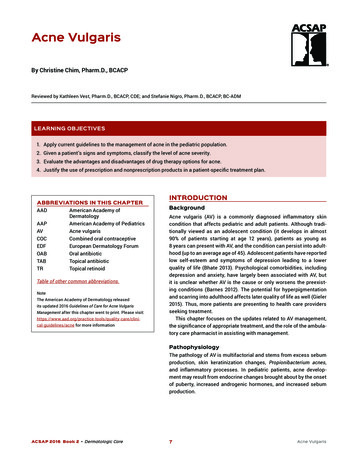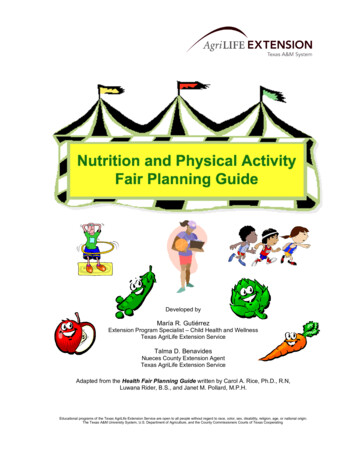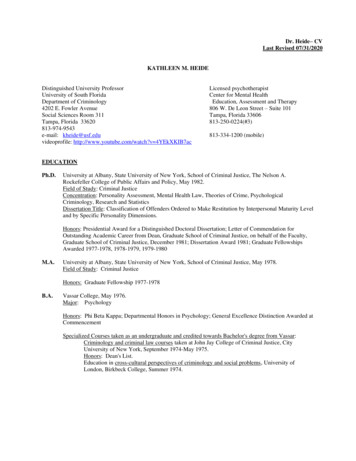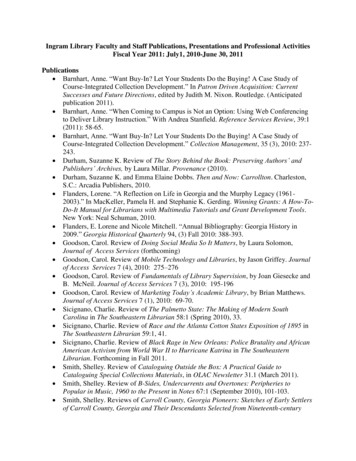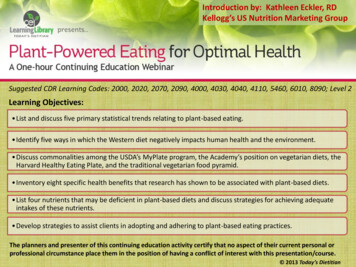
Transcription
Introduction by: Kathleen Eckler, RDKellogg’s US Nutrition Marketing GroupSuggested CDR Learning Codes: 2000, 2020, 2070, 2090, 4000, 4030, 4040, 4110, 5460, 6010, 8090; Level 2Learning Objectives: List and discuss five primary statistical trends relating to plant-based eating. Identify five ways in which the Western diet negatively impacts human health and the environment. Discuss commonalities among the USDA’s MyPlate program, the Academy’s position on vegetarian diets, theHarvard Healthy Eating Plate, and the traditional vegetarian food pyramid. Inventory eight specific health benefits that research has shown to be associated with plant-based diets. List four nutrients that may be deficient in plant-based diets and discuss strategies for achieving adequateintakes of these nutrients. Develop strategies to assist clients in adopting and adhering to plant-based eating practices.The planners and presenter of this continuing education activity certify that no aspect of their current personal orprofessional circumstance place them in the position of having a conflict of interest with this presentation/course. 2013 Today’s Dietitian
2Plant-Powered Eating for Optimal HealthA Webinar by Sharon Palmer, RDPlant-based diets have been associated with a variety of health benefits includinghealthy weight, optimal health and longevity. RDs can help vegans, vegetarians, andomnivores understand the benefits of adopting whole-foods, plant-based eatingstrategies. This webinar provides current research relating to plant-based diets, defineswhat a plant-based diet really is, and develops strategies for implementing plant-basedeating with clients. 2013 Today’s Dietitian
3Eat food.Not too much.Mostly plants.Michael PollanIn Defense of Food 2013 Today’s Dietitian
4Plant-based Eating Growing in PopularityPopular booksVeganista, China Study,The Engine 2 DietCelebrities promotingplant-based dietAlicia Silverstone, BillClinton, Ellen DeGeneres,and more!Plant-Based Bloggers& WebsitesHerbivoracious, Oh MyVeggies, SavvyVegetarian, and more! 2013 Today’s Dietitian
5The Vegetarian Resource Group PollNationwide cross section of 1,010 adults (aged 18 and over)Between 2 to 8%of the U.S.population isvegetarian—about 5-12million adults.16% ofrespondentsreported thatthey eatvegetarian meals(no meat, fish,seafood, orpoultry) morethan half of thetime.17% stated thatthey eat manyvegetarianmeals, but lessthan half thetime.Thus, 1/3 of theU.S. populationis eatingvegetarian mealsa significantamount of thetime—inaddition to thenumber ofvegetarians. 2013 Today’s Dietitian
6Meatless Monday is Growing Organizations, hospitals,schools, universities,restaurants, and more goingmeatless on Mondays. Stars lining up to support themovement, from Oprah toJames Cameron. Key influencers, includingMichael Pollan, supportingthe movement. Even Mario Batali announcedthat he will embraceMeatless Monday in all of his14 restaurants across thecountry. Associated with Johns Hopkins’ BloombergSchool of Public Health 2013 Today’s Dietitian
7Flexitarian: Top Trend for 2012“More consumers in 2012 will become‘Flexitarians,’ those that consciously reducetheir meat intake for health reasons but stilloccasionally enjoy animal protein. One of thebest evidences of this trend is the growingpopularity and social media following of thenonprofit Meatless Monday initiative,developed in association with John Hopkins’Bloomberg School of Public Health.”The Wall Street Journal’sMarket Watch 2013 Today’s Dietitian
8Definition of Plant-based DietsVeganNo animal foodsLacto-Ovo VegetarianDefinition ofa plant-baseddiet is onethat focuseson plantsNo animal flesh, but allows fordairy and eggsPescatarianNo animal flesh, except for fishand seafoodSemi-Vegetarian or “Flexitarian”Small amounts of animal foods 2013 Today’s Dietitian
9Indigenous, Traditional DietsCommon Features: Local whole grain Local legumes Seasonal cultivatedand foraged fruits andvegetables Seeds and nuts Minimally processed Low use of animalfoods 2013 Today’s Dietitian
MediterraneanDiet Pyramid 2013 Today’s Dietitian10
11What We DidWhat We FoundEWG partnered withCleanMetrics, anenvironmental analysisfirm, to assess thegreenhouse gasemissions associatedwith 20 types of meat,fish, dairy andvegetable proteins, aswell as these foods’effects on health.All meat is not createdequal. Lamb, beef,pork and cheesegenerate the mostgreenhouse gases.They also tend to behigh in fat and havethe worstenvironmentalimpacts.Copyright Environmental Working Group, www.ewg.org. Reprinted with permission.
12Copyright Environmental Working Group, www.ewg.org. Reprinted with permission.
13Copyright Environmental Working Group, www.ewg.org. Reprinted with permission.
14Best Choices LentilsTomatoes2% MilkBeansTofuBroccoliWorst Choices SalmonPorkCheeseBeefLambCopyright Environmental Working Group, www.ewg.org. Reprinted with permission.
15Barilla Double Pyramid 2013 Today’s Dietitian
16Optimal Health:Key Motivator for Plant-based Eating“Vegetarian-style eating patternshave been associated with improvedhealth outcomes, including lowerlevels of obesity, a reduced risk ofcardiovascular disease, lower bloodpressure, and lower total mortality.”Dietary Guidelines, 2010 2013 Today’s Dietitian
17Academy’s Position on Vegetarian Diets“Well-planned vegetarian diets are completelyhealthful and nutritionally adequate for peoplethroughout all stages of life and that they have a numberof health advantages, including lower blood cholesterollevels, lower risk of heart disease, lower blood pressurelevels, and lower risk of hypertension and type 2 diabetes.In addition, vegetarians tend to have a lower body weightand lower overall cancer rates, lower intakes of saturatedfat and cholesterol, and higher levels of dietary fiber,magnesium, potassium, vitamins C and E, folate,carotenoids, flavonoids, and other phytochemicals.”Academy of Nutrition and Dietetics 2013 Today’s Dietitian
18Whole, Minimally Processed Plant Foods High in “good” stuff:fiber, vitamins, minerals,healthy fats,phytochemicals, lowglycemic carbs. Low in “bad” stuff:saturated fat, dietarycholesterol, sodium, toxins(nitroso compounds,heterocyclic amines,polycyclic aromatichydrocarbons, glycationend products formed incooking, curing, processingmeats). 2013 Today’s Dietitian
19MyPlate3/4 PlateFilled withPlantFoods 2013 Today’s Dietitian
20 2013 Today’s Dietitian
21Meat Lover Society On average, Americansconsume 8 oz of meat perday – 45% more than theUSDA recommends. Three times the globalaverage of meat. Favorite meat is beef (58%);not eating much fish (5 ozper week—as much as weeat turkey). 2013 Today’s Dietitian
22Typical Restaurant Burger1,149 calories21 grams of saturated fat175 mg cholesterol2,571 mg sodium79 total carbohydrates8 grams of fiber63 grams of proteinTypical Restaurant Steak1,390 calories36 grams of saturated fat 2013 Today’s Dietitian
23Red/Processed Meat Health Risks Harvard meta-analysis: high processed meat 42% higher risk of CHD. (Circulation, 2010) Health Professionals Follow-up Study:100 g/d red meat 19% higher risk type 2diabetes; 50 g/d processed meat 51%increased risk. (AJCN, 2011) NIH-AARP Diet and Health Study: highesttertile for consumption of red meat higherrisk colorectum, esophagus, lung, livercancer; highest tertile for consumption ofprocessed meat higher risk colorectal,lung cancer; both cancer mortality.(AJCN, 2011) 2013 Today’s Dietitian
24Health Benefits for Plant-Based DietLongevityWeigh LessLower Oxidative Stress & InflammationReduced Risk of Heart DiseaseReduced Risk of Type 2 DiabetesLower Risk of CancerHealthy Gut/Immune SystemBrain Protection 2013 Today’s Dietitian
25Longevity EPIC study (cohort with520,000 people in tenEuropean countries),more closely adheredto plant-based diet,longer lifespan (PublicHealth Nutrition, 2007) Diets that includemore whole plantfoods are linked withlonger life span (AJCN,2009) 2013 Today’s Dietitian
26Weigh Less EPIC study, BMI of fish eaters,vegetarians, and particularlyvegans is lower than meateaters. (International Journalof Obesity, 2003) For example, a 55 year oldmale or female vegan weighs30 pounds less thannonvegetarian of similarheight. Consume more fiber, lowglycemic carbs. (DiabetesCare, 2009) 2013 Today’s Dietitian
27Lower Oxidative Stress & Inflammation Studies show that a diet rich inwhole plant foods, such asfruits, vegetables, whole grains,nuts, tea, coffee, red wine inmoderation and olive oil,decreases levels of oxidativestress and inflammation, whichare associated with thedevelopment of chronic disease.(Nutrition, 2004 and JACC, 2006) In the Adventist Health Study II,a vegetarian diet was linked tolower CRP levels, a marker ofinflammation. (Ethn Dis, 2011) 2013 Today’s Dietitian
28Reduced Risk of Heart Disease Several studies show heartbenefits, possibly due tolower inflammation, oxidativestress, blood pressure, LDLlevels. (AJCN, 2009) Analysis of five studiesincluding 76,000 subjectsfound rates of ischemic heartdisease 34% lower invegetarians thannonvegetarians. (AJCN, 1999) 2013 Today’s Dietitian
29Lower Risk of Type 2 DiabetesHarvard review of threecohorts and updated metaanalysis (total of more than442,000 subjects)Red meatlinked with higher risk of type2 diabetes, but when oneserving swapped for nutsevery day, decreased risk by21%, substituting wholegrains reduced risk by 23%.(AJCN, 2011) 2013 Today’s Dietitian
30Lower Risk of Cancer Vegetarians 12% lower overall rateof cancer (British Journal of Cancer,2009). Plant foods linked with protectionagainst mouth, pharynx, esophagus,stomach, lung, pancreas, andprostate cancer; in particular, highfiber plant foods may protect indigestive cancers. (AICR) Study linked plant-based diet to20% lower breast cancer risk.(American Journal of Epidemiology,2011) 2013 Today’s Dietitian
31Healthy Gut/Immune System Increasing evidence fiberrich, plant-based dietpromotes healthy gutmicrobiota, linked toimmune support anddigestive health. EPIC study found lowerrate of hospital admissionsand risk of death fromdiverticular disease amongvegetarians. (BMJ, 2011) 2013 Today’s Dietitian
32Brain Protection Chronic inflammationand oxidative stress leadto development ofAlzheimer’s. High adherence toMediterranean, plantbased diet linked with48% lower risk ofAlzheimer’s disease.(Archives Neurology,2009) 2013 Today’s Dietitian
33Challenges for Plant-Based Eating Misperceptions, such as gettingadequate protein and calciumintake. More food preparation required. Lack of cooking skills regardingbeans, whole grains, tofu. Unfamiliarity with new foods,such as tofu, tempeh, seitan. 2013 Today’s Dietitian
34Developing a Plant-based Eating StyleInclude more whole plant foods, such as plant proteins:Legumes (beans, lentils, and peas)Whole Soy Foods (tofu, tempeh, soy milk)Nuts and Nut Butters (almonds, walnuts, hazelnuts, pecans,pistachios, macadamias, Brazil nuts, peanuts)Seeds and Seed Butters (sunflower, sesame, hemp, chia,pumpkin)Whole grains (quinoa, wheat berries, oats, brown rice) can begood protein source (up to 11 g protein per cup, i.e. Kamut)Vegetables, such as peas, spinach, broccoli (can contain up to 6g protein per cup) 2013 Today’s Dietitian
35The VegetarianFood Pyramid
36Adequate ProteinChoose adequate servings at each meal, depending on needs.Plant proteins, such aslegumes, nuts andseeds, have excellent“protein package”—packed with fiber,micronutrients,phytochemicals andcontain up to 9 gprotein per serving.Whole grains such aswheat can have up to 6 gprotein per ½ cup.Vegetables such asbroccoli can contain 3 gper ½ cup. 2013 Today’s Dietitian
37Nutrient of Concern: CalciumGoal: 1,000 mg for most adults; 1,200 mg a day for women over 50 and men over 70. (DRI)If no dairy, choosetotal of two servingsper day of calciumfortified foods, suchas plant-based milkalternatives, tofu, ororange juice.Choose one dailyserving of dark greenleafy vegetables.May consider takinga calciumsupplement to meetdaily calcium needs. 2013 Today’s Dietitian
38Nutrient of Concern: Vitamin DGoal: 600 mg/day for everyone 1 to 70 years of age. (DRI)If you’re no dairy, itmay be difficult tomeet vitamin Drequirements.Aim for ten minutesof sunlight exposurea day.Consume vitamin-Dfortified foods, suchas soy milk andorange juice, andconsider a vitamin Dsupplement. 2013 Today’s Dietitian
39Nutrient of Concern: Vitamin B12Recommended dietary allowance for adults ages 14 and up is 2.4 mcg per day. (DRI)Available only inanimal foods: meat,fish, poultry, eggs,and dairy products.Also available insome nutritionalyeasts and fortifiedproducts, such ascereal and soy milk.Vegans should take avitamin B12supplement daily. 2013 Today’s Dietitian
40RDs Can Help Offer creative, simple plant-based recipes, or have a vegetarian option in instructions. Help educate on using legumes, soy foods, and whole grains in meals. Guide people to consume a balanced, plant-based diet, with good sources of protein, calcium,and vitamins D and B12. Be aware of vegan and vegetarian preferences, which may vary widely. Teach plant-based cooking classes. Understand intricacies of plant-based products, including taste, cooking use, variations andnutritional profiles. Develop resources: The Vegetarian Resource Group, The Vegetarian Nutrition Dietetic PracticeGroup, Oldways, Loma Linda University, Seventh Day Adventist Dietetic Association. 2013 Today’s Dietitian
41Tips for a Healthy Plant-Based Eating StyleStart the day right. Go veggie at breakfast.Join the Meatless Monday bandwagon.Shop for plants first. Instead of planning your menuaround meat, plan it around plants. 2013 Today’s Dietitian
42Tips for a Healthy Plant-Based Eating StyleIf you eat meat, use it as a seasoning. Cut down onanimal food intake while pushing plants by usingmeat as a flavoring in dishes instead of main event.Create a plant-based pantry list. Many plant-basedfoods like beans and whole grains are shelf-stable,convenient, and economical.Get cooking! Plan at least one night a week to try anew vegetarian recipe. 2013 Today’s Dietitian
43Tips for a Healthy Plant-Based Eating StyleKeep it simple. Not every meal has to involvecookbooks and cutting boards; it can be as easy asblack bean burritos, vegetarian chili, or hummus pitasandwich.Try ethnic flair. Some cultures know how to dovegetarian meals right!Convert your favorite dishes. Turn your favoritemeat-based recipes veggie for an easy dinnersolution. 2013 Today’s Dietitian
44Tips for a Healthy Plant-Based Eating StyleDust off your slow-cooker. Just throw in veggies,herbs, vegetable broth, canned tomatoes, wholegrains, and dried beans; then turn the dial on.Try plant-based dairy products. Try more plantbased alternatives for milk, yogurt, and cheese.Think “yes”. Don’t dwell on what you can’t have,think about what you can have! 2013 Today’s Dietitian
45Today’s Dietitian’s Results Are In!Dietitians gave us their best tips for helping patients incorporate plant-based eating into their dietPuree, chop, or dice vegetablesinto smaller pieces to hide themin dishes and stuffed foods toincrease taste and nutritionwithout the family noticing.Anna Stadler, RD, LDNI introduce people to greensmoothies If possible, wemake a smoothie together sothey can see how simple it is.Hands-on or demo gives themmore confidence than justgetting a recipe.Sheila Ginsberg, MS, RD, CDEWarn clients that not all meatfree foods (especially thepackaged products) are healthyjust because they are meatfree. Encourage them to readfood labels and try to followthe 5 ingredient rule (try tostick to foods that only include5 ingredients).Noreen Gallo, MS, RD, LDI recommend to my clients toeat a fruit or vegetable (orboth!) at each meal andsnack. That way they’ll get 5 ormore servings in eachday. Repeat this day after dayand you have a positivehealthy habit.Heather Klug, MEd, RD, CDAdd veggies to your traditionalrecipes. Try adding a can ofpumpkin puree to your favoritechili recipe. You can't taste thepumpkin at all, but it boosts thenutrient profile and gives it afabulous texture!Sharon Lehrman, MPH, RD, LD 2013 Today’s Dietitian
46Today’s Dietitian’s Results Are In!Dietitians gave us their best tips for helping patients incorporate plant-based eating into their dietBuy in bulk. Purchase morewhen there is a good deal orwhen something is especiallydelicious. Most fruits andvegetables keep well in thefreezer and then you will alwayshave them on hand.Kylie Harmison, RDBe open to adding differentspices and herbs, it canreally tantalize the taste buds!Every day you can have a minifood adventure trying newfoods and flavors whilebecoming healthier.Serena Garges, RD, LDNOn Sunday afternoons, turn onsome good music and invest anhour to chop up veggies andprepare "food for theweek" This way you have"ready to go" options to getyou through the week forlunches, meals and side dishes!Bev Benda, RD, LRDNo time to slice fresh veggiesfor a salad? Add frozen peas orfrozen mixed veggiesinstead. They will be defrostedby lunch and ready to top withyour favorite dressing.Jane Becker, RD, LDStart your grocery store trip inthe produce isle. Only shop onthe outside of the store. Thishelps eliminate most processedfoods and helps your cartcontain fresh foods. Fruits andvegetables should fill up thebottom of your cart.MaLinda Coffman, MS, RD, LD 2013 Today’s Dietitian
47References on Plant-Based Nutrition The Vegetarian Resource Group: http://www.vrg.org The Vegetarian Nutrition Dietetic Practice Group:http://vndpg.org/ The Academy of Nutrition and Dietetics Position onVegetarian d 8357 The Plant-Powered Diet by Sharon Palmer, RD, the PlantPowered Dietitian: www.sharonpalmer.com The Dietitian’s Guide to Vegetarian Diets: Issues andApplications, Third Edition by Reed Mangels, VirginiaMessina and Mark Messina 2013 Today’s Dietitian
48Supplemental MaterialsClick the “Reference” tab on CE.TodaysDietitian.com forsupplemental materials associated with this webinar including: Slideshow PDF Tips for a Healthy Plant-Based Eating Style Plant-Based Eating Tips for Patients Plant-Powered Protein List Plant-Based Dairy Alternatives Guide Cooking Up Legumes Guide 2013 Today’s Dietitian
49Certificate Credit ClaimingYou must score an 8 out of 10 or better on theassociated exam in order to claim your credits anddownload your certificate.You can re-access your certificate at any time byfollowing these instructions:1.2.3.4.5.Log on to ce.todaysdietitian.comGo to the “My Account” sectionClick on the “My Activities” tabClick “download” next to the webinar titleDownload and print your certificate 2013 Today’s Dietitian
Thank You50Sharon Palmer, RDinfo@sharonpalmer.com 2013 Today’s Dietitian
Health Professionals Follow-up Study: 100 g/d red meat 19% higher risk type 2 diabetes; 50 g/d processed meat 51% increased risk. (AJCN, 2011) NIH-AARP Diet and Health Study: highest tertile for consumption of red meat higher risk colorectum, esophagu


